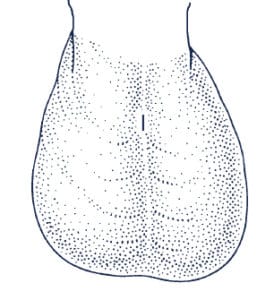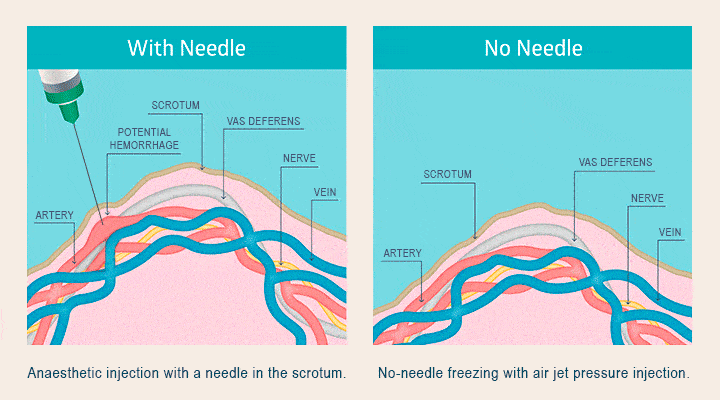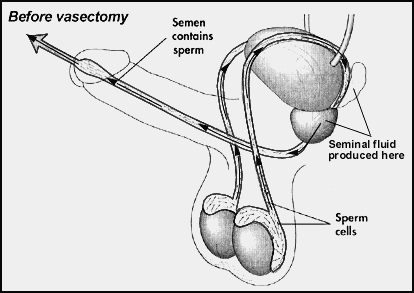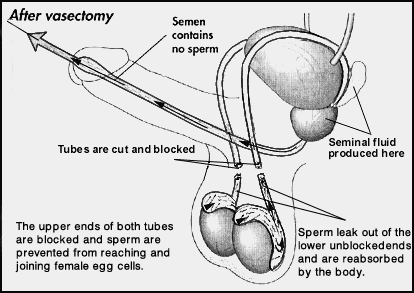No Scalpel Vasectomy at Gentle Procedures Saskatchewan
Gentle Procedures Saskatchewan offers no-scalpel, no-needle vasectomy for Saskatchewan men.
The quick and virtually painless procedure is done in comfortable procedure rooms at our vasectomy clinics in Saskatoon, Regina, and Swift Current.
Only a tiny puncture is required, rather than incisions, with no sutures needed.
The small opening is often closed by the following day and recovery times are relatively short.
Studies show that no-scalpel vasectomies have a complication rate eight times lower than conventional approaches and involve less discomfort.
Request Information
No-Needle No-Scalpel Vasectomy for Saskatchewan Men
No-scalpel vasectomy is different from a conventional vasectomy in the way the doctor gets to the vas tubes. In addition, an improved method of local anesthesia helps make the procedure virtually painless.
In a conventional vasectomy, after the scrotum has been numbed with a local anesthetic, the doctor makes two cuts in the skin and lifts out each tube in turn, cutting and blocking them. Then the doctor stitches the cuts closed.
In a no-scalpel vasectomy the doctor locates the tubes under the skin and holds them in place with a small clamp. Instead of making two incisions, the doctor makes one tiny puncture with a special instrument. The same instrument is used to gently stretch the opening so the tubes can be reached. This line accurately represents the actual size of the puncture. (I) Through this tiny opening both tubes are temporarily lifted out and then blocked using heat cauterization.
The first scrotum image below (at left) shows how the vas tubes are accessed via the small opening. The centre image gives you an idea of the actual size of the cut that will be made during your no-scalpel vasectomy. The third image is just shown so you can compare the no-scalpel technique with the cuts made for a conventional vasectomy.

No-scalpel procedure: Pulling out one of the two vas tubes

No-scalpel procedure: No stitches are needed to close the tiny opening

Conventional vasectomy: Two moderate incisions stitched closed.
No-Needle Anesthesia
Our clinic also offers a different method of anesthesia called “no-needle” anesthesia, which eliminates the need for a needle entering the scrotum.
This is accomplished by using an air pressure device which is quicker, and more comfortable for patients.
Most men prefer a needle-free vasectomy procedure.

Ensuring Sterilization – Fascial Interposition
Dr. Mulla also carries out what many studies describe as a crucial step, called fascial interposition.
This step involves tying the sheath or covering of the vas over one end of the cut tube with a dissolving thread, to create a natural barrier between the two cut ends.
Fascial interposition is accomplished by using metal clips or dissolving thread/suture. Metal clips are left permanently in the scrotum once applied. Dr. Mulla’s preference is to use dissolving suture, so as not to leave any foreign material in the body.
The fine tubes are then gently placed back into the scrotum and the tiny opening heals within days and soon becomes invisible. There is very little bleeding with the no-scalpel technique. No stitches are needed to close the tiny opening, which heals quickly, without a scar.


Benefits of No-Scalpel Male Vasectomy in SK
Studies have shown an eight times lower complication rate, quicker healing, and less intra-operative discomfort for a no-scalpel vasectomy compared to the more conventional approach. We feel that it is clearly preferable to do a vasectomy through a tiny central opening versus making larger cuts requiring sutures and a more complex recovery. The addition of fascial interposition and skin glue closure are also benefits for most men undergoing vasectomy.
Register online anytime.
Vasectomy Basics – How Does Vasectomy Prevent Pregnancy?
Sperm are made in a man’s testes. During sexual climax, the sperm travels through two tubes (the right vas and left vas) in the scrotum, mix with semen (from the prostate and seminal vesicles), and come out of the penis. In a vasectomy, these tubes are blocked so the sperm cannot reach the semen. As a result, you will ejaculate semen without sperm.
A man cannot make his partner pregnant without sperm.
Also keep in mind that the sperm makes up a minute portion of the ejaculate, approximately 1% of the volume. Therefore, you will not notice any change in the ejaculation post-vasectomy. Your sexual experience, erections, performance, ejaculations are essentially unchanged. Only change is: No more sperm, no more pregnancy!


Open-Ended Type Vasectomy in Saskatchewan
Our SK vasectomy doctor performs an “Open-Ended” vasectomy technique, where the vas tube from the bottom end is left open (uncauterized), while the end of the tube leading to the penis is cauterized. As detailed above, fascial interposition is also performed to ensure the success of your vasectomy.
While studies are not conclusive, it is postulated that leaving one end open may permit sperm to leak out, resulting in less postoperative discomfort. This is because there is no sudden pressure back-up to the testicles. The leakage does not increase risk of pregnancy, as the other end of the vas is sealed. Sperm are simply reabsorbed back into the testicles in a natural process that causes no pain or pressure.
Studies also indicate that it reduces the time it takes for a vasectomy, and vasectomy reversal may also be easier to perform later, if desired. We do not recommend getting a vasectomy if you think you may eventually want a reversal. You should consider vasectomy as a permanent contraceptive method.
Not all vasectomists around the world perform this open ended technique, and some prefer to cauterize both ends. At Gentle Procedures Saskatchewan our doctor is able to maintain our high success rates while also offering the potential benefits of an Open-Ended vasectomy.
Call Us to Book
Or For Any Questions
Possible Risks and Complications with a Vasectomy Procedure
There are no life-threatening complications associated with NSV (No-Scalpel Vasectomies). The minor complications that can arise are generally short-lived and resolve with ice, rest, anti-inflammatories, and time. Long term safety with NSV is considered excellent, although all of the following are possible:
- Mild discomfort: Some men report a mild aching sensation to the scrotum for a few hours to a few days after the procedure.
- Mild bleeding into the scrotum (1/400): May form a small tender swelling for a few days.
- Scrotal hematoma (1/1000): A major bleed into the scrotum causing a grapefruit size tender scrotum which may take months to heal.
- Infection (1/500): May present as redness and tenderness at the healing site opening or non specific tenderness within the scrotum, which may require oral antibiotics. (More serious infection is possible i.e. abscess formation that may require intravenous antibiotics 1/1000).
- Epididymitis (1/100): Tender swelling of the epididymis, the tube connecting the vas deferens and the testes.
- Sperm granuloma (1/500): A small, potentially uncomfortable, bead-like structure made of leaked sperm that may develop at the site where the tube was cut and blocked.
- Post Vasectomy Pain Syndrome (1/1000): A rare complication of a persisting dull ache in the testicle where the inflammation does not settle down. It may resolve on its own or may need another surgical procedure.
- Failure (less than 1/1000): Because a doctor has inadequately blocked one or both tubes, or because one or both tubes have rejoined.
- Reactive hydrocele (1/10,000): A swelling in the scrotum that occurs when fluid collects in the thin sheath surrounding a testicle.
Does a Vasectomy Hurt?
With no-needle anesthesia and our no-scalpel technique the pain is minimized. You will likely have some aching or other minor discomfort in the day or two after your surgery, but you can be sure that our gentle vasectomy procedure supports an optimal result with the least amount of pain.
It will only hurt a little bit – and not during the procedure.
Laser Vasectomy in Regina?
Laser vasectomy is not a medical procedure currently available to SK men. We are not aware of any vasectomy doctors in Saskatoon, Regina, or elsewhere, that offer laser vasectomy.
Sometimes no-scalpel vasectomy is confused with laser vasectomy. Some people may assume that because no stitches are needed and no scalpel is used a laser may be the tool applied to the operation – but this is not the case.
As detailed above our method involves the use of specialized instruments that obviate the need for scalpels and stitches. The traditional scalpel is replaced with devices for puncturing a small hole and holding men’s vas tubes during the no-scalpel vasectomy procedure.
The traditional syringe is replaced with an air applicator which permits anaesthetic to be applied through the scrotal skin. Men find this more comfortable, and it is generally much preferred over an injection in the scrotum.
Laser Vasectomy – Maybe someday.
The scalpel-less, minimally invasive vasectomy method used by Dr. Mulla at our Saskatchewan vasectomy clinics is modern, comfortable, and effective.
Lasers are not used for vasectomy – but if a good laser vasectomy technique is developed we will definitely examine its potential benefits relative to our current methods.
Saskatchewan Circumcision & Vasectomy Clinic Serving Saskatoon, Regina and Swift Current
Call Us
Book Online
Quick Contact

